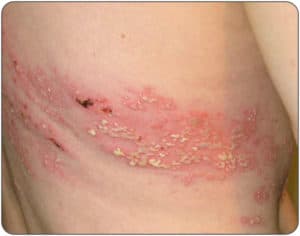Podcast Ep 9: Pneumonia, Endocarditis, Colchicine Toxicity, Herpes Zoster, & More

We’re sitting on a train oblivious to the fact that it’s moving at 80 miles per hour, but anyone sitting outside the train watches it whiz right by! This is the value of learning to see the world through the eyes of others. -Andy Grove
Welcome back to episode 9! This week we review many high yield associations such as organisms and valvular endocarditis. The episodes are short and sweet, so you can even listen twice! We will start this week’s episode off with a Rapid Review of the previous week’s highlights. Be sure to listen to last week’s episode if you missed it.

- Hematuria without RBCs on urine microscopy would be seen in rhabdomyolysis
- Hematuria and hearing loss is associated with Alport syndrome.
- Hematuria with hemoptysis is associated with Goodpasture syndrome.
- Be cognizant of the increased incidence of hematuria caused by schistosomiasis in recent immigrants to the United States.
- VP shunt obstruction occurs more frequently proximally than distally due to either choroid plexus obstruction or increased protein within the CSF.
- Eikenella is a common contaminant of fight bites. Treatment is typically with amoxicillin-clavulanate.
Now onto this week’s podcast
Question 1
A 45-year-old man, with a long history of alcohol abuse, presents to the ED complaining of fever and cough for three days. Which of the following organisms is the most common cause of pneumonia in this population?
A. Group A Streptococcus
B. Klebsiella pneumoniae
C. Legionella pneumophilia
D. Streptococcus pneumoniae
Question 2
A 45-year-old man with a history of alcohol abuse presents with numbness and weakness of the left hand. He states he slept on a bench last night and awoke this morning with the symptoms. Physical examination reveals decreased sensation over the first, second, and third digits and a wrist drop. What management is indicated?
A. CT of the cervical spine
B. MRI of the brain
C. Noncontrast CT scan of the head
D. Wrist splint and follow up with neurology
Question 3
Which of the following is true regarding infective endocarditis?
A. Janeway lesions are tender erythematous macules
B. Surgery is indicated for fungal endocarditis
C. The mitral valve is most commonly involved in intravenous drug abusers
D. The presence of fever is one of the major Duke criteria for the diagnosis of endocarditis
Question 4
A 75-year-old man with dementia presents to the ED with severe vomiting and diarrhea. He is admitted to the hospital for renal failure and dehydration. An infectious workup is initiated because he has a leukocytosis. The following day, he develops pancytopenia, renal failure, and acute respiratory distress syndrome. He is transferred to the intensive care unit where he has a cardiac arrest and expires. When the family arrives, they report the patient was in his usual state of health until three days ago, when he suffered a gout flare and began to take excessive amounts of a new medication to control the pain. Ingestion of what medication could account for this patient’s presentation and clinical course?
A. Acetaminophen
B. Colchicine
C. Indomethacin
D. Oxycodone
E. Prednisone
Question 5

A 55-year-old man presents with right-sided chest pain and a rash for 4 days as seen above. What management should be initiated?
A. Diphenhydramine
B. Pain control
C. Topical antibiotics
D. Topical corticosteroids
Question 6
What ultrasound finding is consistent with a pneumothorax?
A. A lines
B. Absence of lung sliding
C. B lines
D. Presence of lung sliding
Video – Lung sliding, pneumothorax

- Streptococcus pneumoniae is classically associated with rusty colored sputum. Klebsiella pneumoniae is associated with currant jelly sputum.
- The most common cause of pneumonia in alcoholics is Streptococcus pneumoniae.
- Radial nerve palsy presents with wrist drop and decreased sensation over the first through third fingers. Treatment is supportive with a wrist splint.
- The mnemonic FROM JANE can be used to help remember many of the findings associated with bacterial endocarditis. Fever, Roth spots, Osler nodes, Murmur, Janeway lesions, Anemia, Nail-bed hemorrhages, Emboli.
- Tricuspid endocarditis is frequently seen in IV drug users. Tricuspid endocarditis is also frequently caused by Staphylococcus aureus.
- Native valve endocarditis is most commonly seen in the mitral > aortic valves.
- Streptococcus bovis endocarditis is associated with GI malignancy.
- Symptomatic colchicine overdoses must be admitted because of an elevated risk of sudden cardiac Complications include renal failure, rhabdomyolysis, bone marrow suppression, and ARDS.
- Herpes zoster is treated with multimodal analgesic based pain management along with oral acyclovir and prednisone.
- Absence of lung sliding is indicative of a pneumothorax. A lines are horizontal lines that are the normal reflection of the pleura. B lines are vertical “headlights” that are indicative of pulmonary edema.
Hope you enjoyed this week’s episode. Let us know how to make this better by sending feedback to Roshcast@roshreview.com.
Here is last week’s emergency medicine board review podcast where Jeff and review fight bites, VP shunts, cyanotic heart lesions, hemolytic uremic syndrome, and much more
Until next time,
Jeff and Nachi
P.S. If you’re looking for thousands of more high-quality emergency medicine board review questions, please visit Rosh Review.
Get Free Access and Join Thousands of Happy Learners
You must be logged in to post a comment.





Comments (0)